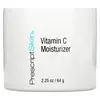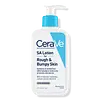What's inside
What's inside
 Key Ingredients
Key Ingredients

 Benefits
Benefits

 Concerns
Concerns

 Ingredients Side-by-side
Ingredients Side-by-side

Water
Skin ConditioningCaprylic/Capric Triglyceride
MaskingGlycerin
HumectantGlyceryl Stearate Se
EmulsifyingCarthamus Tinctorius Seed Oil
MaskingSorbitol
HumectantStearic Acid
CleansingDimethicone
EmollientGlyceryl Stearate
EmollientPEG-100 Stearate
3-O-Ethyl Ascorbic Acid
Skin ConditioningAloe Barbadensis Leaf Juice
Skin ConditioningTitanium Dioxide
Cosmetic ColorantAvena Sativa Kernel Extract
AbrasiveHamamelis Virginiana Extract
AntiseborrhoeicSalix Alba Bark Extract
AstringentPogostemon Cablin Leaf Extract
PerfumingChamomilla Recutita Flower Extract
MaskingCitrus Limon Peel Extract
EmollientHumulus Lupulus Extract
AntimicrobialLavandula Angustifolia Flower/Leaf/Stem Extract
MaskingCalendula Officinalis Flower Extract
MaskingCamellia Sinensis Leaf Extract
AntimicrobialCucumis Sativus Seed Extract
Skin ConditioningPyrus Malus Fruit Extract
Skin ConditioningSpirulina Platensis Extract
Skin ProtectingBHT
AntioxidantCarbomer
Emulsion StabilisingCitric Acid
BufferingAscorbic Acid
AntioxidantSodium Hydroxide
BufferingLactic Acid
BufferingMalic Acid
BufferingGluconic Acid
Disodium EDTA
Glycolic Acid
BufferingMelaleuca Alternifolia Leaf Oil
AntioxidantTocopheryl Acetate
AntioxidantRetinyl Palmitate
Skin ConditioningSalicylic Acid
MaskingTartaric Acid
BufferingPhenoxyethanol
PreservativeEthylhexylglycerin
Skin ConditioningCitronellol
PerfumingCitral
PerfumingLimonene
PerfumingLinalool
PerfumingParfum
MaskingWater, Caprylic/Capric Triglyceride, Glycerin, Glyceryl Stearate Se, Carthamus Tinctorius Seed Oil, Sorbitol, Stearic Acid, Dimethicone, Glyceryl Stearate, PEG-100 Stearate, 3-O-Ethyl Ascorbic Acid, Aloe Barbadensis Leaf Juice, Titanium Dioxide, Avena Sativa Kernel Extract, Hamamelis Virginiana Extract, Salix Alba Bark Extract, Pogostemon Cablin Leaf Extract, Chamomilla Recutita Flower Extract, Citrus Limon Peel Extract, Humulus Lupulus Extract, Lavandula Angustifolia Flower/Leaf/Stem Extract, Calendula Officinalis Flower Extract, Camellia Sinensis Leaf Extract, Cucumis Sativus Seed Extract, Pyrus Malus Fruit Extract, Spirulina Platensis Extract, BHT, Carbomer, Citric Acid, Ascorbic Acid, Sodium Hydroxide, Lactic Acid, Malic Acid, Gluconic Acid, Disodium EDTA, Glycolic Acid, Melaleuca Alternifolia Leaf Oil, Tocopheryl Acetate, Retinyl Palmitate, Salicylic Acid, Tartaric Acid, Phenoxyethanol, Ethylhexylglycerin, Citronellol, Citral, Limonene, Linalool, Parfum
Salicylic Acid
MaskingWater
Skin ConditioningGlycerin
HumectantParaffinum Liquidum
EmollientTriethanolamine
BufferingGlyceryl Stearate
EmollientAmmonium Lactate
BufferingPEG-100 Stearate
Cetearyl Alcohol
EmollientCetyl Alcohol
EmollientZea Mays Oil
EmulsifyingCeramide NP
Skin ConditioningCeramide AP
Skin ConditioningCeramide EOP
Skin ConditioningCarbomer
Emulsion StabilisingBehentrimonium Methosulfate
Dimethicone
EmollientMethylparaben
PreservativeSodium Lauroyl Lactylate
EmulsifyingCholecalciferol
Cholesterol
EmollientDisodium EDTA
Propylparaben
PreservativeHydrolyzed Hyaluronic Acid
HumectantPhytosphingosine
Skin ConditioningXanthan Gum
EmulsifyingSalicylic Acid, Water, Glycerin, Paraffinum Liquidum, Triethanolamine, Glyceryl Stearate, Ammonium Lactate, PEG-100 Stearate, Cetearyl Alcohol, Cetyl Alcohol, Zea Mays Oil, Ceramide NP, Ceramide AP, Ceramide EOP, Carbomer, Behentrimonium Methosulfate, Dimethicone, Methylparaben, Sodium Lauroyl Lactylate, Cholecalciferol, Cholesterol, Disodium EDTA, Propylparaben, Hydrolyzed Hyaluronic Acid, Phytosphingosine, Xanthan Gum
 Reviews
Reviews

Ingredients Explained
These ingredients are found in both products.
Ingredients higher up in an ingredient list are typically present in a larger amount.
Carbomer is a polymer of acrylic acid. Its main role is to create a gel consistency.
A high amount of carbomer can cause pilling or balling up of products. Don't worry, most products contain 1% or less of carbomer.
Dimethicone is a type of synthetic silicone created from natural materials such as quartz.
What it does:
Dimethicone comes in different viscosities:
Depending on the viscosity, dimethicone has different properties.
Ingredients lists don't always show which type is used, so we recommend reaching out to the brand if you have questions about the viscosity.
This ingredient is unlikely to cause irritation because it does not get absorbed into skin. However, people with silicone allergies should be careful about using this ingredient.
Note: Dimethicone may contribute to pilling. This is because it is not oil or water soluble, so pilling may occur when layered with products. When mixed with heavy oils in a formula, the outcome is also quite greasy.
Learn more about DimethiconeDisodium EDTA plays a role in making products more stable by aiding other preservatives.
It is a chelating agent, meaning it neutralizes metal ions that may be found in a product.
Disodium EDTA is a salt of edetic acid and is found to be safe in cosmetic ingredients.
Learn more about Disodium EDTAGlycerin is already naturally found in your skin. It helps moisturize and protect your skin.
A study from 2016 found glycerin to be more effective as a humectant than AHAs and hyaluronic acid.
As a humectant, it helps the skin stay hydrated by pulling moisture to your skin. The low molecular weight of glycerin allows it to pull moisture into the deeper layers of your skin.
Hydrated skin improves your skin barrier; Your skin barrier helps protect against irritants and bacteria.
Glycerin has also been found to have antimicrobial and antiviral properties. Due to these properties, glycerin is often used in wound and burn treatments.
In cosmetics, glycerin is usually derived from plants such as soybean or palm. However, it can also be sourced from animals, such as tallow or animal fat.
This ingredient is organic, colorless, odorless, and non-toxic.
Glycerin is the name for this ingredient in American English. British English uses Glycerol/Glycerine.
Learn more about GlycerinGlyceryl Stearate is a mix of glycerin and stearic acid.
It is used to stabilize the mixing of water and oil ingredients. By preventing these ingredients from separating, it can help elongate shelf life. It can also help thicken the product's texture.
As an emollient, it helps soften skin and supports barrier-replenishing ingredients.
In cosmetics, Glyceryl Stearate is often made from vegetable oils or synthetically produced.
This ingredient may not be fungal-acne safe
Fun fact: The human body also creates Glyceryl Stearate naturally.
Learn more about Glyceryl StearatePeg-100 Stearate is an emollient and emulsifier. As an emollient, it helps keep skin soft by trapping moisture in. On the other hand, emulsifiers help prevent oil and water from separating in a product.
PEGS are a hydrophilic polyether compound . There are 100 ethylene oxide monomers in Peg-100 Stearate. Peg-100 Stearate is polyethylene glycol ester of stearic acid.
Salicylic Acid (also known as beta hydroxy acid or BHA) is a well-known ingredient for treating skin that struggles with acne and clogged pores. It exfoliates both the skin's surface and deep within the pores to help clear out buildup, control oil, and reduce inflammation.
Unlike AHAs (alpha hydroxy acids), salicylic acid is oil-soluble. This allows it to penetrate into pores which makes it especially effective for treating blackheads and preventing future breakouts.
Salicylic acid is also known for its soothing properties. It has a similar structure to aspirin and can calm inflamed or irritated skin, making it a good option for acne-prone skin that is also sensitive.
Concentrations of 0.5-2% are recognized by the U.S. FDA as an over-the-counter topical acne product.
It can cause irritation and/or dryness if one's skin already has a compromised moisture barrier, so it's best to focus on repairing that before introducing this ingredient into your routine.
While salicylic acid does not increase sun sensitivity, it’s still important to wear sunscreen daily to protect your skin.
If you are looking for the ingredient called BHA or Butylated Hydroxyanisole, click here.
Learn more about Salicylic AcidWater. It's the most common cosmetic ingredient of all. You'll usually see it at the top of ingredient lists, meaning that it makes up the largest part of the product.
So why is it so popular? Water most often acts as a solvent - this means that it helps dissolve other ingredients into the formulation.
You'll also recognize water as that liquid we all need to stay alive. If you see this, drink a glass of water. Stay hydrated!
Learn more about Water